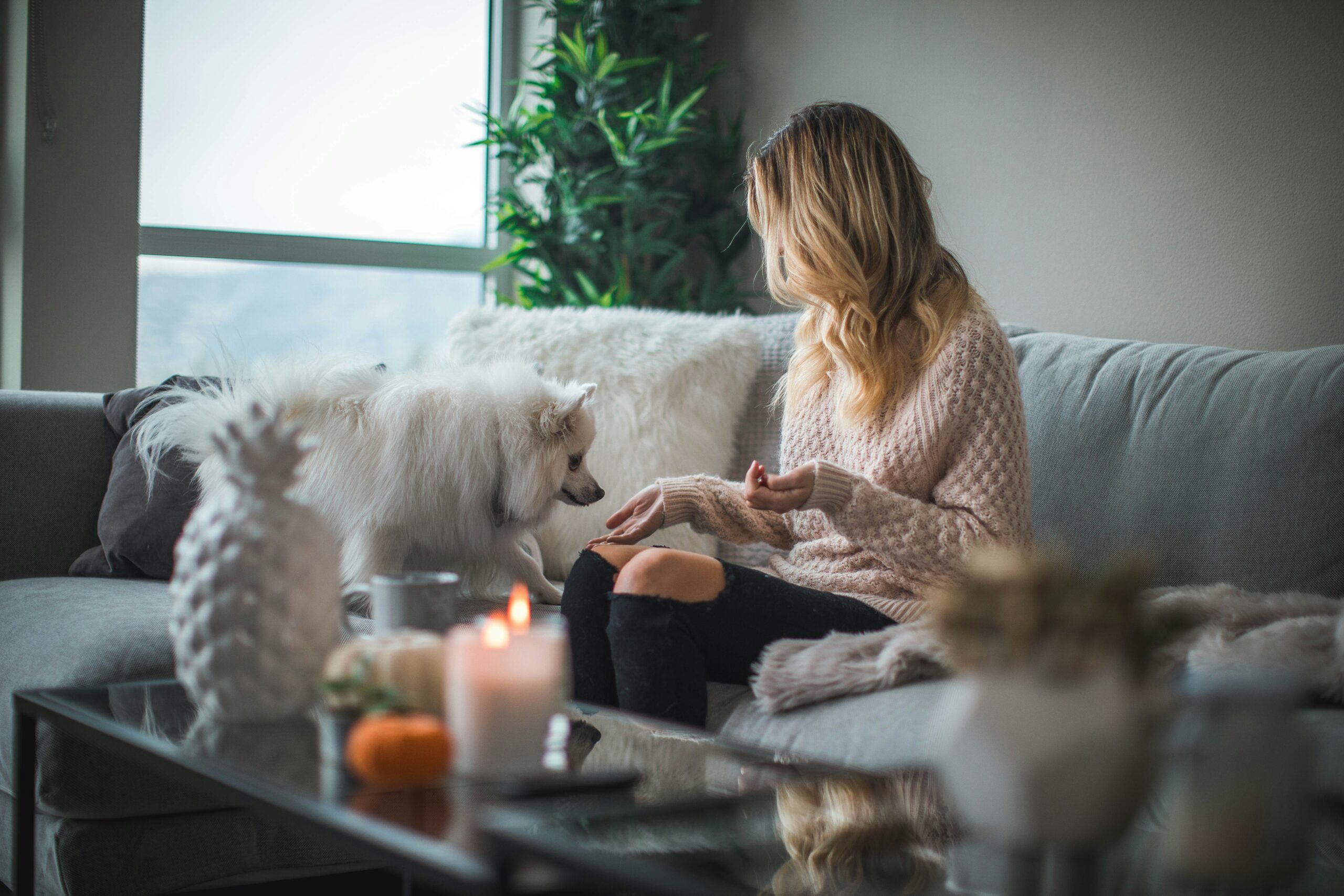Dog Anxiety: Causes, Symptoms, and How to Calm Your Pup

Introduction
Just like humans, dogs can experience anxiety. Whether it’s due to separation from their owner, loud noises like thunderstorms, or unfamiliar environments, anxiety in dogs can manifest in various ways and significantly impact their well-being. Understanding the causes, recognizing the symptoms, and learning how to calm your anxious dog are crucial steps in ensuring their happiness and health. This comprehensive guide delves into the intricacies of dog anxiety, offering practical tips and solutions to help your beloved pet live a stress-free life.
1. Understanding Dog Anxiety
1.1 What Is Dog Anxiety?
Dog anxiety is a condition that can affect dogs of all breeds and ages. It’s characterized by a feeling of unease or fear that can lead to various behavioral changes. While occasional anxiety is a normal response to certain stimuli, chronic anxiety can be debilitating for a dog and may require intervention.
1.2 Types of Dog Anxiety
There are several types of anxiety that dogs may experience:
- Separation Anxiety: One of the most common forms, this occurs when a dog becomes distressed upon being left alone or separated from their owner. Dogs with separation anxiety may exhibit destructive behavior, excessive barking, or attempts to escape.
- Noise Anxiety: Dogs with noise anxiety react fearfully to loud noises like fireworks, thunderstorms, or even household appliances. This type of anxiety is particularly challenging during events like the Fourth of July.
- Social Anxiety: Some dogs become anxious around unfamiliar people or animals, often leading to aggressive or fearful behaviors. Social anxiety is common in dogs that haven’t been properly socialized as puppies.
- Generalized Anxiety: This is a chronic condition where a dog is in a constant state of anxiety, regardless of specific triggers. It can be caused by a variety of factors, including genetics, past trauma, or environmental factors.
1.3 Common Triggers of Dog Anxiety
Understanding what triggers your dog’s anxiety is the first step in managing it. Common triggers include:
- Changes in Environment: Moving to a new home, changes in routine, or the arrival of a new family member can all be stressful for dogs.
- Loud Noises: Thunderstorms, fireworks, and other loud noises can trigger anxiety, especially in dogs with noise sensitivity.
- Separation from Owners: Being left alone, even for short periods, can cause extreme anxiety in dogs with separation anxiety.
- Lack of Socialization: Dogs that haven’t been exposed to a variety of people, animals, and environments as puppies may develop anxiety later in life.
- Past Trauma: Dogs that have been rescued from abusive situations or have experienced a traumatic event may develop anxiety as a result.
2. Recognizing the Symptoms of Dog Anxiety
2.1 Behavioral Symptoms
Recognizing the signs of anxiety in your dog is essential for addressing the issue promptly. Common behavioral symptoms include:
- Excessive Barking or Howling: Dogs with anxiety often vocalize their distress through excessive barking, whining, or howling, especially when left alone.
- Destructive Behavior: Chewing on furniture, digging, or attempting to escape can be signs of anxiety, particularly in cases of separation anxiety.
- Pacing or Restlessness: An anxious dog may pace back and forth or exhibit signs of restlessness, especially when the trigger is present.
- Aggression: Some anxious dogs may become aggressive, especially if they feel threatened by the trigger.
- Excessive Licking or Chewing: Dogs may lick or chew their paws excessively as a way to cope with anxiety, sometimes leading to skin issues.
2.2 Physical Symptoms
In addition to behavioral changes, anxiety can also manifest physically in dogs. Common physical symptoms include:
- Panting and Drooling: While panting can be normal, excessive panting, especially when not associated with exercise or heat, can indicate anxiety. Some dogs may also drool excessively.
- Shaking or Trembling: Dogs may shake or tremble when they are anxious, especially during events like thunderstorms or fireworks.
- Loss of Appetite: An anxious dog may lose interest in food, leading to weight loss if the anxiety is chronic.
- Diarrhea or Digestive Issues: Anxiety can cause digestive upset, leading to diarrhea or other gastrointestinal issues.
- Dilated Pupils and Tense Muscles: Physical signs like dilated pupils or tense muscles can indicate that your dog is in a heightened state of anxiety.
2.3 Subtle Signs of Anxiety
Not all signs of anxiety are obvious. Some dogs may exhibit more subtle symptoms, such as:
- Avoidance Behavior: An anxious dog may try to hide or avoid certain situations, such as retreating to a quiet corner during a thunderstorm.
- Yawning or Lip Licking: Dogs may yawn or lick their lips as a way to self-soothe, even when they aren’t tired or hungry.
- Clinginess: Some dogs may become overly clingy or follow their owner around constantly when they are feeling anxious.
3. Causes of Dog Anxiety
3.1 Genetics and Breed Predisposition
Some dogs are genetically predisposed to anxiety. Certain breeds, such as German Shepherds, Border Collies, and Cocker Spaniels, are more prone to anxiety disorders due to their temperament and genetic makeup. Understanding your dog’s breed can help you anticipate potential anxiety issues.
3.2 Early Life Experiences
A dog’s early life experiences can have a profound impact on their anxiety levels. Puppies that are not properly socialized or are exposed to traumatic experiences during their formative weeks may develop anxiety later in life. This is why socialization and positive experiences are crucial during puppyhood.
3.3 Environmental Factors
The environment in which a dog lives can also contribute to anxiety. Dogs that live in chaotic or unpredictable environments, or those that are frequently exposed to loud noises, may develop anxiety over time. Additionally, major changes in a dog’s environment, such as moving to a new home or the loss of a family member, can trigger anxiety.
3.4 Health Issues
Underlying health problems can also cause or exacerbate anxiety in dogs. Painful conditions, hormonal imbalances, or neurological issues can all contribute to increased anxiety. If you suspect your dog’s anxiety may be related to a health issue, it’s important to consult with a veterinarian.
3.5 Lack of Exercise or Mental Stimulation
Dogs that don’t receive enough physical exercise or mental stimulation are more likely to develop anxiety. Exercise and play are essential for a dog’s mental well-being, and a lack of these can lead to pent-up energy and stress.
4. How to Calm an Anxious Dog
4.1 Create a Safe Space
One of the most effective ways to calm an anxious dog is to create a safe, quiet space where they can retreat when they’re feeling stressed. This could be a cozy corner of a room, a crate with soft bedding, or a designated “safe zone” in your home. Make sure the space is away from loud noises or any triggers that may cause anxiety.
4.2 Use Calming Aids
There are several calming aids available that can help reduce anxiety in dogs:
- Pheromone Diffusers: These devices release synthetic versions of calming pheromones that can help soothe anxious dogs. Products like Adaptil mimic the pheromones that a mother dog would release to calm her puppies.
- Calming Supplements: There are various natural supplements available that can help reduce anxiety, such as L-theanine, chamomile, or valerian root. Always consult with your veterinarian before giving your dog any new supplements.
- Pressure Wraps: Products like the Thundershirt apply gentle pressure to your dog’s body, similar to swaddling a baby, which can have a calming effect.
4.3 Practice Desensitization and Counterconditioning
Desensitization and counterconditioning are effective techniques for reducing anxiety in dogs. These methods involve gradually exposing your dog to the source of their anxiety in a controlled way and pairing it with positive experiences.
- Desensitization: Start by exposing your dog to the anxiety trigger at a low intensity and gradually increase the exposure over time. For example, if your dog is afraid of loud noises, you might start by playing a recording of thunder at a low volume while rewarding your dog with treats.
- Counterconditioning: This technique involves changing your dog’s emotional response to the trigger. For example, if your dog is anxious about being left alone, you could pair your departure with something positive, like a treat-filled puzzle toy, to create a positive association.
4.4 Provide Regular Exercise and Mental Stimulation
Ensuring your dog gets plenty of physical exercise and mental stimulation is crucial for reducing anxiety. Regular walks, playtime, and interactive toys can help burn off excess energy and keep your dog mentally engaged.
4.5 Implement a Consistent Routine
Dogs thrive on routine, and having a consistent daily schedule can help reduce anxiety. Feeding, walking, and bedtime should occur at the same time each day to provide your dog with a sense of stability and predictability.
4.6 Seek Professional Help
If your dog’s anxiety is severe or persistent, it may be necessary to seek professional help. A certified dog behaviorist or trainer can work with you and your dog to develop a customized plan to manage their anxiety. In some cases, your veterinarian may recommend
anti-anxiety medication to help your dog cope.
4.7 Try Behavior Modification Training
Behavior modification training can be a highly effective way to reduce anxiety in dogs. This type of training focuses on changing the dog’s behavior through positive reinforcement techniques. For example, rewarding calm behavior when your dog is exposed to a trigger can help reduce their anxiety over time.
4.8 Use Aromatherapy
Aromatherapy can be a soothing way to help calm an anxious dog. Certain essential oils, such as lavender and chamomile, have calming properties that can help reduce anxiety. Be sure to use pet-safe essential oils and consult with your veterinarian before using them.
4.9 Consider Alternative Therapies
Alternative therapies, such as acupuncture or massage, can also be beneficial for reducing anxiety in dogs. These therapies can help relax your dog’s muscles, reduce tension, and promote a sense of calm.
4.10 Stay Calm and Patient
Finally, it’s important to remain calm and patient when dealing with an anxious dog. Dogs are highly attuned to their owner’s emotions, and if you are stressed or anxious, your dog is likely to pick up on that. Stay calm, speak in a soothing tone, and give your dog the time they need to adjust.
5. Preventing Dog Anxiety
5.1 Early Socialization
Proper socialization during puppyhood is one of the most effective ways to prevent anxiety later in life. Expose your puppy to a variety of people, animals, and environments in a positive and controlled way to help them become well-adjusted adults.
5.2 Create Positive Associations
Creating positive associations with potentially stressful situations can help prevent anxiety. For example, if your dog is nervous about car rides, pair the experience with something positive, like a favorite treat or toy.
5.3 Maintain a Balanced Lifestyle
A balanced lifestyle that includes regular exercise, mental stimulation, and social interaction is key to preventing anxiety in dogs. Make sure your dog has plenty of opportunities to engage in physical activity and play.
5.4 Monitor Changes in Behavior
Regularly monitor your dog’s behavior for any signs of anxiety, and address any changes promptly. Early intervention can prevent anxiety from becoming a chronic issue.
5.5 Stay Attuned to Your Dog’s Needs
Every dog is unique, and understanding your dog’s individual needs and preferences is crucial for preventing anxiety. Pay attention to what triggers your dog’s anxiety and take steps to minimize or manage those triggers.
Conclusion
Dog anxiety is a common and sometimes challenging issue, but with the right understanding and tools, it can be effectively managed. By recognizing the causes and symptoms, providing a calming environment, and using the appropriate techniques and treatments, you can help your dog overcome their anxiety and live a happy, stress-free life. Remember, patience and consistency are key, and with your support, your pup can find the peace and comfort they deserve.




